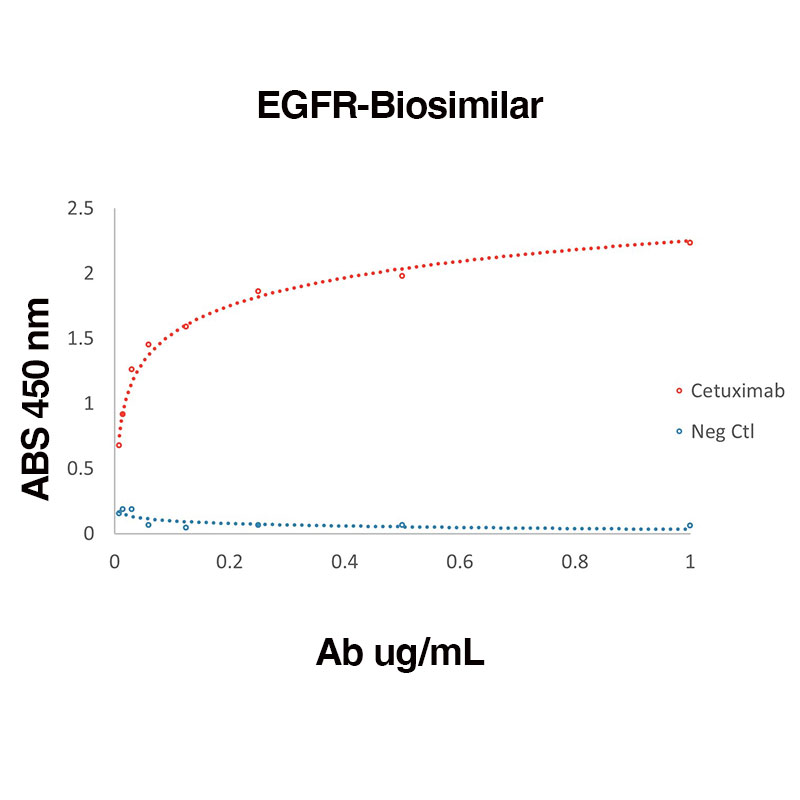Anti-Human EGFR (Cetuximab)
| Code | Size | Price |
|---|
| LEI-LT600-Custom | Custom | Enquire |
Quantity:
| LEI-LT600-1mg | 1.0 mg | £207.00 |
Quantity:
| LEI-LT600-5mg | 5.0 mg | £532.00 |
Quantity:
| LEI-LT600-25mg | 25 mg | £1,677.00 |
Quantity:
| LEI-LT600-50mg | 50 mg | £2,902.00 |
Quantity:
| LEI-LT600-100mg | 100 mg | £4,066.00 |
Quantity:
Prices exclude any Taxes / VAT
Overview
Host Type: Human
Antibody Isotype: Human IgG1κ
Antibody Clonality: Monoclonal
Antibody Clone: C225
Regulatory Status: RUO
Target Species: Human
Applications:
- Enzyme-Linked Immunosorbent Assay (ELISA)
- Flow Cytometry
- Functional Study
- Immunocytochemistry (ICC)
- Immunohistochemistry (IHC)
- Mass Cytometry (CyTOF)
Shipping:
2 - 8°C Wet Ice
Storage:
Functional grade biosimilar antibodies may be stored sterile as received at 2-8°C for up to one month. For longer term storage aseptically aliquot in working volumes without diluting and store at -80°C.?Avoid Repeated Freeze Thaw Cycles.
Images
Further Information
Antigen Distribution:
EGFR is ubiquitously expressed and found in the plasma membrane.
Concentration:
? 5.0 mg/ml
Conjugate/Tag/Label:
Purified No Carrier Protein
Format:
This biosimilar antibody is aseptically packaged and formulated in 0.01 M phosphate buffered saline (150 mM NaCl) PBS pH 7.2 - 7.4 with no carrier protein, potassium, calcium or preservatives added. Due to inherent biochemical properties of antibodies, certain products may be prone to precipitation over time. Precipitation may be removed by aseptic centrifugation and/or filtration.
Formulation:
This biosimilar antibody is aseptically packaged and formulated in 0.01 M phosphate buffered saline (150 mM NaCl) PBS pH 7.2 - 7.4 with no carrier protein, potassium, calcium or preservatives added. Due to inherent biochemical properties of antibodies, certain products may be prone to precipitation over time. Precipitation may be removed by aseptic centrifugation and/or filtration.
Immunogen:
Human EGFR/ErbB1
Long Description:
EGFR is a 170 kD transmembrane glycoprotein that is part of the ErbB family of receptors within the protein kinase superfamily. EGFR is one of four closely related receptor tyrosine kinases: EGFR (ErbB-1), HER2/c-neu (ErbB-2), Her 3 (ErbB-3) and Her 4 (ErbB-4). EGFR is essential for various processes including controlling cell growth and differentiation and ductal development of the mammary glands. Ligand binding induces dimerization and autophosphorylation. It consists of a glycosylated extracellular domain which binds to EGF and an intracellular domain with tyrosine-kinase activity necessary for signal transduction. TGFα, vaccinia virus growth factor, and related growth factors can also bind to and signal through EGFR. Abnormal EGFR signaling has been implicated in inflammatory diseases such as psoriasis, eczema and atherosclerosis. Alzheimer's disease is linked with poor signaling of the EGFR and other receptor tyrosine kinases. Furthermore, over-expression of the EGFR is linked with the growth of various tumors. EGFR has been identified as an oncogene, a gene which in certain circumstances can transform a cell into a tumor cell, which has led to the therapeutic development of anticancer EGFR inhibitors. EGFR is a well-established target for both mAbs and specific tyrosine kinase inhibitors. Anti-Human EGFR (Cetuximab) utilizes the same variable regions from the therapeutic antibody Cetuximab making it ideal for research projects.
NCBI Gene:
1956
Purity:
?95% monomer by analytical SEC
Target:
EGFR
References
1. Tortora, G. et al. (1999) Clin Cancer Res. 5(4):909-16.
2. Myers, J. et al. (2006) Clin Cancer Res. 12(2): 600?607.



